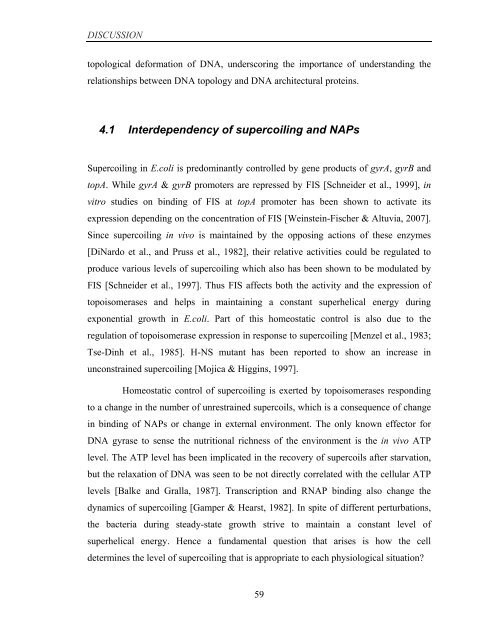Coordinated regulation of gene expression by E ... - Jacobs University
Coordinated regulation of gene expression by E ... - Jacobs University
Coordinated regulation of gene expression by E ... - Jacobs University
Create successful ePaper yourself
Turn your PDF publications into a flip-book with our unique Google optimized e-Paper software.
DISCUSSION<br />
topological deformation <strong>of</strong> DNA, underscoring the importance <strong>of</strong> understanding the<br />
relationships between DNA topology and DNA architectural proteins.<br />
4.1 Interdependency <strong>of</strong> supercoiling and NAPs<br />
Supercoiling in E.coli is predominantly controlled <strong>by</strong> <strong>gene</strong> products <strong>of</strong> gyrA, gyrB and<br />
topA. While gyrA & gyrB promoters are repressed <strong>by</strong> FIS [Schneider et al., 1999], in<br />
vitro studies on binding <strong>of</strong> FIS at topA promoter has been shown to activate its<br />
<strong>expression</strong> depending on the concentration <strong>of</strong> FIS [Weinstein-Fischer & Altuvia, 2007].<br />
Since supercoiling in vivo is maintained <strong>by</strong> the opposing actions <strong>of</strong> these enzymes<br />
[DiNardo et al., and Pruss et al., 1982], their relative activities could be regulated to<br />
produce various levels <strong>of</strong> supercoiling which also has been shown to be modulated <strong>by</strong><br />
FIS [Schneider et al., 1997]. Thus FIS affects both the activity and the <strong>expression</strong> <strong>of</strong><br />
topoisomerases and helps in maintaining a constant superhelical energy during<br />
exponential growth in E.coli. Part <strong>of</strong> this homeostatic control is also due to the<br />
<strong>regulation</strong> <strong>of</strong> topoisomerase <strong>expression</strong> in response to supercoiling [Menzel et al., 1983;<br />
Tse-Dinh et al., 1985]. H-NS mutant has been reported to show an increase in<br />
unconstrained supercoiling [Mojica & Higgins, 1997].<br />
Homeostatic control <strong>of</strong> supercoiling is exerted <strong>by</strong> topoisomerases responding<br />
to a change in the number <strong>of</strong> unrestrained supercoils, which is a consequence <strong>of</strong> change<br />
in binding <strong>of</strong> NAPs or change in external environment. The only known effector for<br />
DNA gyrase to sense the nutritional richness <strong>of</strong> the environment is the in vivo ATP<br />
level. The ATP level has been implicated in the recovery <strong>of</strong> supercoils after starvation,<br />
but the relaxation <strong>of</strong> DNA was seen to be not directly correlated with the cellular ATP<br />
levels [Balke and Gralla, 1987]. Transcription and RNAP binding also change the<br />
dynamics <strong>of</strong> supercoiling [Gamper & Hearst, 1982]. In spite <strong>of</strong> different perturbations,<br />
the bacteria during steady-state growth strive to maintain a constant level <strong>of</strong><br />
superhelical energy. Hence a fundamental question that arises is how the cell<br />
determines the level <strong>of</strong> supercoiling that is appropriate to each physiological situation?<br />
59
















